Introduction
Lenovo has a range of consumer-oriented computers named IdeaPad. The range has a number of different series within it, each designed for a different purpose or user group. The Yoga series is a line of tablets and laptops. The name “Yoga” was chosen because the laptops have hinges that allow the screen to be fully folded back (up to 360°) to convert a laptop into a tablet. A Yoga laptop can also be placed in “tent” or “stand” mode for showing presentations or movies.
Back in October 2015, I reviewed Lenovo’s Yoga 900 Ultrabook. In January 2016, Lenovo announced a variant of the 900: the Yoga 900s. Slightly smaller and even thinner and lighter than the Yoga 900, this is intended as the ultimate Ultrabook.
A few days ago, courtesy of Lenovo, UPS delivered a Yoga 900s to me for review. This blog post is the result and focuses on the Yoga 900s hardware and its performance. When I reviewed the Yoga 900, I made a separate post looking at the software environment of the Yoga 900, i.e. the setting up of Windows 10, and a look at the software bundled with the Yoga 900 by Lenovo. The software side of the Yoga 900s is essentially the same as for the Yoga 900, so refer to that post for my findings on the software experience.
Here’s a table that shows a quick comparison between the Yoga 900 and the new Yoga 900s:
| Yoga 900 | Yoga 900s | |
| OS | Windows 10 64 / 10 Pro 64* | Windows 10 64 / 10 Pro 64** |
| Screen | 13.3”QHD+ 3200×1800 IPS, 300nits 10 point Touch |
12.5” 1920×1080 FHD** or 2560x1440QHD 10 point Touch |
| CPU | Intel Core i7-6500U* / Intel Core i5-6200U |
Intel Core m7- 6Y75 |
| Graphics | Intel HD Graphics 520 | Intel HD Graphics 515 |
| Memory | Up to 16GB DDR3L | 8GB DDR3L |
| Storage | 256GB/512GB SSD | 256GB/512GB SSD** |
| Active Pen support | No | Yes** |
| Audio | JBL stereo speakers with Waves Audio and DOLBY Home Theatre certification | JBL stereo speakers with Waves Audio and DOLBY Home Theatre certification |
| Webcam | 720p, 30 fps | 720p, 30 fps |
| Connectivity | 802.11 a/c Wireless Bluetooth V4.0 |
802.11 a/c Wireless Bluetooth V4.0 |
| Battery Life | 66 Watt Hour – 9.2 hours | 54 Watt Hour – 10.5 hours |
| Ports | 2xUSB 3.0, 1xDC-in with USB 2.0 function, 4in1 card reader (SD, MMC, SDXC, SDHC), USB-C, Audio Combo Jack | 1xUSB 3.0, 1xDC-in with USB 2.0 function, USB-C, Audio Combo Jack |
| Weight | 1.29 kg. (2.84 lbs) | 999 gm. (2.2 lbs) |
| Dimensions |
324 x 225 x 14.9 mm (12.75” x 8.85” x 0.58”) |
304 x 212 x 12.8mm (12”x 8.35” x 0.5”) |
Table 1
*There is an i7-6500U, 16GB and 256GB SSD fitted on the Yoga 900 I have, and it is running Windows 10 Pro.
**The Yoga 900s I have for review has a 1920×1080 FHD display, with 512GB SSD and Windows 10 Pro installed. The unit I received did not ship with an active pen included in the box.
The Yogas are examples of what Intel calls the Ultrabook class of laptop. That is, they are ultrathin, using solid-state drives, low-power Intel Core processors, and (because of their thinness) do not have optical disc drives or full-size Ethernet ports.
Unboxing
The box is a minimalist design: white (on top) and orange (underneath), with four icons on the side representing the four Yoga configurations (Laptop, Stand, Tent, and Tablet).
Like the boxes of the earlier Yogas, it contains a slick piece of paper engineering – after taking off the lid, you fold back the two flaps covering the top, and as you do so, the Yoga 900s rises out of the box to greet you. It’s a nice touch.
Underneath the Yoga 900s are compartments that hold the power adaptor, the special USB power cable, and a sleeve containing the quickstart user guide. Since my review machine is pre-production, the guide was missing.
A side-by-side comparison with the Yoga 900 shows that the 900s is clearly slightly smaller. The Yoga 900s came in the Champagne Gold colour, while the Yoga 900 that I have is finished in sliver.
Yoga 900 Externals
The hinge on the Yoga 900s is the distinctive “watchband” design, which I personally find appealing and which works smoothly and very well.
The Yoga 900 introduced a a USB-C port, supporting USB 3.0, native DisplayPort 1.2 video and VGA/HDMI output and which replaced the Micro-HDMI port of the Yoga 3 Pro. The Yoga 900s continues this direction.
Because the 900s is smaller than the 900, some features have had to be rearranged or dropped altogether. The recessed button that activates OneKey Recovery (see the post on the Yoga 900’s software) has moved from the right hand side of the Yoga 900 to the left on the Yoga 900s. Probably more serious for some, one button and two ports have now disappeared from the Yoga 900s. Just as the Yoga 900 dropped the physical volume controls present on the Yoga 3 Pro, the Yoga 900s goes one step further and has also dropped the display rotation lock button that was present on both earlier machines. The Yoga 900s also has one less USB 3.0 port than the earlier machines, and the card reader port has been removed altogether. Customers who used the card reader port in the past (e.g. photographers transferring images from their camera memory cards to the computer) will now have to use an external card reader attached via USB.
Here’s a comparison of the righthand side of the Yoga 900s (on top) and the Yoga 900:
The Yoga 900s shows (from left to right) the power button, the headphone jack and a USB 3.0 port that can also be used to charge external devices.
The lefthand side comparison:
In the photo above, the Yoga 900s shows (from left to right) the orange-coloured charging port, the USB C port, and the recessed OneKey Recovery button. The charging port can also act as a standard USB 2.0 port. Lenovo provide a special USB cable for charging their Yoga machines. It has a connector that is physically different from a standard USB male cable (it has a small “nub” on one side). Here’s a photo of the special USB charging cable connector (above) compared with a standard USB 2.0 connector (below):
The smaller size of the Yoga 900s compared to the Yoga 900 also means some rearrangement of the keyboard layout. Thankfully, it still has the sixth row of keys that was introduced on the Yoga 900. However, the keyboard is only 26 cm wide, compared with 28.4 cm on the Yoga 900. That means the rightmost column of keys has gone, resulting in one key missing altogether (the right-click menu key), with some keys moved around, or with different function combinations assigned to them.
Here’s the keyboard of the Yoga 900:
Note the right-click menu key between the Alt and Ctrl keys to the right of the Spacebar. And now here’s the keyboard of the Yoga 900s:
The Right-click menu key has gone. I can’t say that I like the fact that the right Shift key and the up-arrow keys have effectively been switched around in this arrangement. I suspect that for some people that will take some getting used to.
The keyboard backlight has the same two illumination levels as in the Yoga 900, as opposed to the single level of the Yoga 3 Pro. The champagne gold colour of the keys is a good contrast with the black surround. Apart from the rearrangement, the keyboard feels pleasant to use, and is comparable with that of the Yoga 900.
The trackpad appears to be the same in both machines, with an area of 60mm x 90mm. It’s a Synaptics trackpad, that unfortunately has not been certified by Microsoft as a Windows Precision Touchpad, perhaps because it is slightly smaller than Microsoft’s recommended optimal size of 65mm x 105mm. This also means that the trackpad settings are not integrated into Windows 10 Settings. More on the trackpad and keyboard in the Yoga’s Modes: Laptop section.
While the Yoga 900 had a QHD high-resolution (3200 x 1800) display as standard, the Yoga 900s will offer a QHD (2560×1440) display as an option. My review unit came with a standard FHD (1920 x 1080) display with 10-point touch and support for an active pen (no pen was supplied, however). To be honest, at this physical size (12.5 inches diagonally), my old eyes are perfectly satisfied with FHD resolution. The pursuit of ever-higher resolution in laptops is somewhat lost on me. It causes more drain on battery life, and can introduce scaling issues with older Windows software. What I do regret is that Lenovo has stuck with a display ratio of 16:9. See my further thoughts on this in the Yoga’s Modes section.
Lenovo has kept the aesthetic of the Yoga 900 by having a single piece of glass in the lid of the Yoga 900s. Both have a (very difficult to see) Windows button (with no haptic feedback) positioned below the display for use primarily when in Tablet mode. As I did in my review of the Yoga 900, I would argue that, with the advent of Windows 10, the Windows button has become redundant, since the Windows Taskbar with its Start button is always present – even in Tablet mode.
At the top of the screen is the Yoga 900s’s webcam; capable of 720p @ 30 fps (the same as for the Yoga 900), along with the dual-array microphone. The speaker grilles, with JBL speakers behind them, are positioned underneath on the Yogas.
Yoga 900 Internals
After hearing feedback from customers that the performance of the Core M processor in the Yoga 3 Pro was slower than anticipated, Lenovo introduced the latest (6th) generation of Intel Core processors, codenamed “Skylake”, in the Yoga 900. Two versions are available in the Yoga 900 range; a Core i5 and a Core i7 model.
So it’s a bit of a surprise to see that the Yoga 900s has once more gone back to the Core M processor. However, it is also of the Skylake generation, so it should be an improvement over the earlier Core M processor in the Yoga 3 Pro. Being a Skylake generation Core M device, the Yoga 900s is not equipped with cooling fans, unlike the Yoga 900 models. So it is completely silent in operation. Skylake also introduces a new generation of the graphics processor architecture, and the Yoga 900s has an Intel HD Graphics 515 engine (the Yoga 900 has the Intel Graphics HD 520). The Benchmarks section will tell the story.
The Yoga 900s has 8 GB system memory installed as standard, whilst the Yoga 900 can have up to 16GB. Storage for both Yogas is the same; either 256 GB or 512 GB SSDs can be specified. However, while the Yoga 900 had a SATA interface to the SSD, the Yoga 900s is equipped with the more efficient NVM Express interface.
The wireless connectivity technologies and interfaces are the same in both Yogas; they support 802.11 A/C Wi-Fi and Bluetooth version 4.0.
The battery capacity in the Yoga 900s has been trimmed back to 54 Watt hours from the 66 Watt hours in the Yoga 900. However, this is more capacity than the rather disappointing 44 Watt hours of the Yoga 3 Pro.
And here’s my hobbyhorse again – like almost all laptops on the market today, there is no built-in GNSS to feed GPS coordinate data to the Windows Location service. I just feel that mobile devices should have a GNSS chip fitted as standard. Downloadable maps for map and navigation apps are supported directly by Windows 10, but I still can’t use the Yoga 900s (or indeed any of the Yogas) off the grid without an additional Bluetooth GPS logger to track its position.
However, that omission apart, the Yoga 900s is a very attractive looking Ultrabook, with a good display (with pen and touch support) and connectivity options.
Benchmarks
PassMark Benchmarks
PassMark Software provide benchmarking software and hardware. I downloaded their Performance Test 8.0 software and used it to run benchmarks on both Yogas (note: the Yoga 900 here is not the same 8GB pre-production machine as I reviewed back in October; it is a production machine fitted with 16GB memory). I’ve also included the results from the Yoga 3 Pro, as this was an Ultrabook that used the previous generation of the Intel Core M CPU. The results are shown in Table 2 below. I also downloaded HWMonitor from CPUID, to record the maximum temperature of the CPU reached when running the benchmarks.
| Yoga 900s | Yoga 900 | Yoga 3 Pro | |
| PassMark | 1623.6 | 1821 | 1575 |
| CPU Mark | 2860 | 4493 | 3628 |
| 2D Graphics Mark | 373.2 | 393.4 | 338.8 |
| 3D Graphics Mark | 435.6 | 426.6 | 392.9 |
| Memory Mark | 1528 | 1992 | 1598 |
| Disk Mark | 8139 | 3511 | 3208 |
| Max CPU Temperature | 62°C | 67°C | 71°C |
Notice the substantial improvement in the Disk Mark – that is doubtless because of the inclusion of the NVM Express interface – and, despite the lack of a fan, the maximum temperature reached by the CPU is not high.
Windows System Assessment Tool
The Windows System Assessment Tool was first introduced by Microsoft in Windows Vista as a means to compare the performance of the hardware of Windows PCs. For Windows Vista and Windows 7, Microsoft provided an applet (the Windows Experience Index applet) to display the results. Although Microsoft no longer provides this applet in Windows 8.1 and Windows 10, the assessment telemetry is still in place and can be used by third-party tools to display the Windows Experience Index. I used the WEI tool from ChrisPC to display the results for all the Yogas: the Yoga 900s, Yoga 900, and the Yoga 3 Pro.
These benchmarks also demonstrate that, while clearly not matching the performance of the full Core i7 CPU of the Yoga 900, the Core M CPU in the Yoga 900s has improved performance over the previous generation used in the Yoga 3 Pro.
The Yoga 900s is a decent performer overall, no doubt helped by the fact that it has the best disk performance of the three machines.
Battery Life Test
Lenovo claims that the Yoga 900s battery can last for 10.5 hours between charges when playing HD video at 200nits. I did a simple test of battery life under the following conditions:
- Display always on at 50% brightness
- Speakers at 100% volume with Dolby Audio on and set to music playback
- Continuous music playback via Groove Music
- Music streamed from a media server via WiFi
Under these conditions, after 9 hours continuous play, the battery still had 25% charge left. This is good, and far better than the Yoga 900, which ran out of puff completely after only 6.5 hours under the same conditions.
Performance summary
As a result of this testing, it seems clear that the Yoga 900s will perform very well in activities involving both productivity (office work) and media consumption (watching movies/videos and listening to music). Battery life is much improved over that of the Yoga 900.
Yoga’s Modes
This section is basically a repeat of the story I laid out in the review of the Yoga 900 from last October. The points remain, for the most part, the same for the Yoga 900s.
A prime selling point of the Yoga is the fact that it can be folded into a variety of modes. At the time of introduction of the original Yoga back in September 2012, this was a unique innovation. Since then, the concept has been copied by other manufacturers such as Dell, HP, Toshiba and ASUS, which proves that imitation is indeed the sincerest form of flattery. It also clearly demonstrates that the concept is perceived to have market value. Lenovo followed up with the introduction of the “watchband” hinge in September 2014, and now with the Yoga 900 we can see both innovations in a mature form.
These are the four modes of the Yoga:
Laptop
The traditional laptop mode is probably the starting point for most people, and the mode in which I suspect most people will be using it for the majority of the time.
The Yoga 900s keyboard is good, but compared to the Yoga 900, I think it would be placed second by some people. It does have an extended keyboard (a dedicated top row of function keys), and a quality feel. However, the keyboard is smaller than that on the Yoga 900, which has led to some compromises. These might take some getting used to, particularly if you have been using a Yoga 900 already.
The trackpad is a Synaptics device that has not been certified as a Windows Precision Touchpad by Microsoft. The result is that it is not integrated in Windows 10 Settings, and Synaptics mimics the required Windows 10 touchpad gestures in their own driver. I also note that there have been complaints about the software driver in the community support forums of Lenovo. The latest version of the driver seems to have addressed the issues. Nonetheless, I feel that Lenovo should get their trackpads properly certified and fully integrated into Windows 10.
The FHD display is good. Subjectively, it feels somewhat less bright than the QHD display on my Yoga 900, but it is bright enough for me. It’s a 16:9 ratio display, ideal for watching movies. For office work (e.g. word processing in Word, Excel), I personally prefer at least a 16:10 ratio. Even better would be the 3:2 ratio of Microsoft’s Surface range, or indeed of the Lenovo ThinkPad X1 Tablet. The 16:9 ratio is also not ideal in the Tablet mode (see later). The Yoga 900s has a large bezel area surrounding the display, particularly along the bottom. It should be possible to fit a 16:10 ratio screen that is the same width as the current display into the Yoga’s lid. If the (now redundant) Windows Button were to be dropped in the next Yoga generation, this would be very easy to do. The overall dimensions of the Yoga would then remain the same, but having a 16:10 ratio display would serve the Laptop and Tablet modes far better than the current 16:9 ratio display, in my opinion.
Tent
This mode is ideal for media (movies and videos) presentations, particularly in space restricted situations, e.g. on a shelf or an aircraft table. For viewing movies, of course, the 16:9 ratio of the display is now ideal. Couple the Yoga with a wireless presenter, and you can use this mode for PowerPoint presentations as well. In this mode the keyboard and trackpad are automatically disabled.
Stand
As an alternative to the Tent mode, the Stand mode can be used for media and PowerPoint presentations. It requires more space than the Tent mode, but the screen can be set to a greater range of angles for the best viewing experience. The keyboard and trackpad are automatically disabled in this mode also.
Tablet
The last mode is where the lid is completely folded back over the (disabled) keyboard, and to convert the Yoga 900s into a tablet. You can select to have Windows 10 automatically switch into Tablet mode, or to give you the option to switch manually. In this mode, the 10-point touchscreen and support for an active pen come into their own. I found that the size of the Yoga 900 (and the Yoga 3 Pro before it) made for a slightly unwieldy tablet. The smaller size and weight of the Yoga 900s works better for me. The overall size is very close to that of an A4 pad of paper, just 7mm longer. So the size (and light weight) of the Yoga 900s is good, but unfortunately I find the 16:9 display ratio not ideal in tablet mode.
The Yoga 900s has pen support, which the Yoga 900 did not have. Lenovo now use the new Wacom AES technology, which uses pens powered by battery or capacitor. I’ve ordered a Lenovo Pro Pen, which uses the AES technology. It will take a couple of weeks to arrive (I think Lenovo must be handcrafting it from the finest plastic somewhere in China), so I’ll add a note to this review about the pen performance at some point in the future.
Talking of A4 pads of paper brings up one last point. One of the frequent uses of a tablet is for reading books or magazines. And once again, the 16:9 ratio of the Yoga 900s or the Yoga 900 provides (in my view) a diminished reading experience over devices with 16:10 ratios (e.g. the ThinkPad 10) or 3:2 ratios (e.g. the Surface 3 or ThinkPad X1 Tablet). Pages are rendered longer and narrower in 16:9, and the reading experience suffers as a result.
I would certainly make use of the tablet mode of the Yoga 900s, particularly now that it has pen support. It will be interesting to see over the next few weeks (after the pen finally arrives!) which 2-in-1 device I reach for the most often: the Yoga 900s or my Surface 3. I’ll be reporting back on this later.
Overall Conclusions
In my review of the Yoga 900, I stated that the Yoga 900 was a clear advance over its predecessor, the Yoga 3 Pro. The Yoga 900s could be thought of as a refinement of the Yoga 900, a refinement that will appeal to a slightly different audience. If you want power and performance, and arguably a more ergonomic keyboard, then the Yoga 900 is your choice. If you want a smaller, lighter Ultrabook, with power for everyday productivity, and support for an active pen, then the Yoga 900s is an excellent choice. Small, but (almost) perfectly formed. The plus points of the Yoga 900s are:
- Sufficient performance suitable for a wide range of consumer and business users
- Good keyboard
- Good battery life between charges (better than the Yoga 900)
- Good display
- Active pen support
- Build quality and style
- Light weight (makes Tablet mode a joy not a chore)
- Flexibility in use
There are some minus points (in my view):
- The trackpad is not certified as a Windows Precision Touchpad
- Unusual keyboard layout
- No physical volume controls or display rotation lock button
- Only one USB 3.0 port (the Yoga 900 has two)
- Few Lenovo apps deliver real value-add (see this post for details).
And perhaps Lenovo could give consideration to the following for the next generation of the Yoga:
- Move from a 16:9 screen ratio to at least 16:10, if not 3:2. Lenovo has done this for the ThinkPad X1 Tablet – why not for IdeaPad Yogas?
- Include a GNSS chip to deliver GPS coordinates in real-time to the Windows Location service.
- Put back the volume control rocker switch to support the ergonomics of Tablet mode.
It is a fine example of the Ultrabook class of computer. It also offers additional flexibility with the configurations that it can be folded into. I like it.

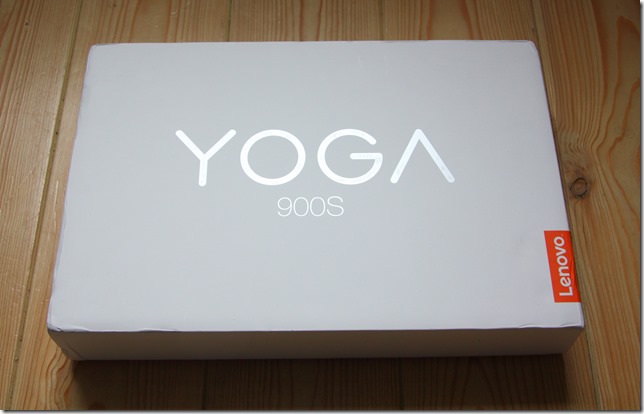





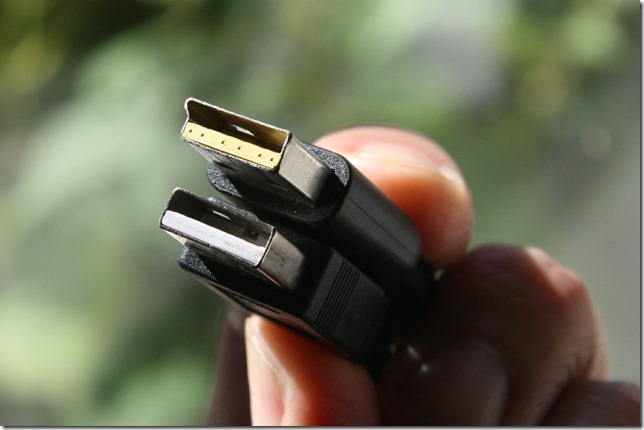

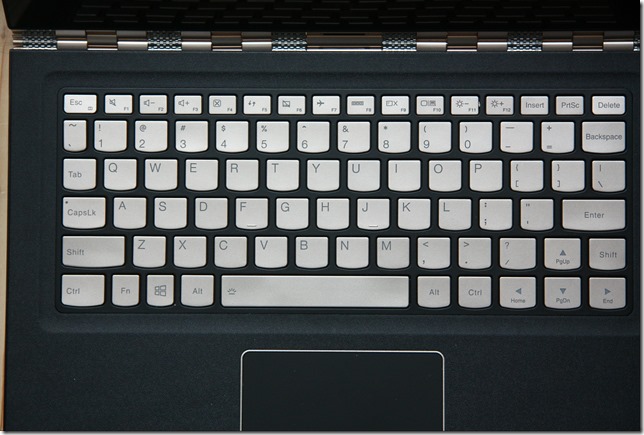
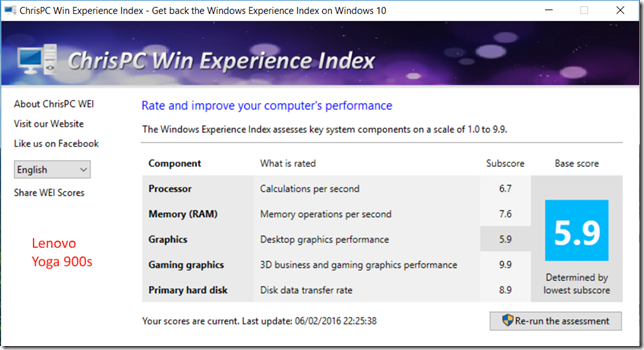
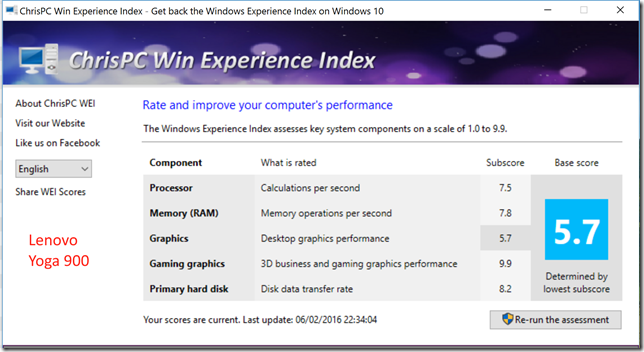
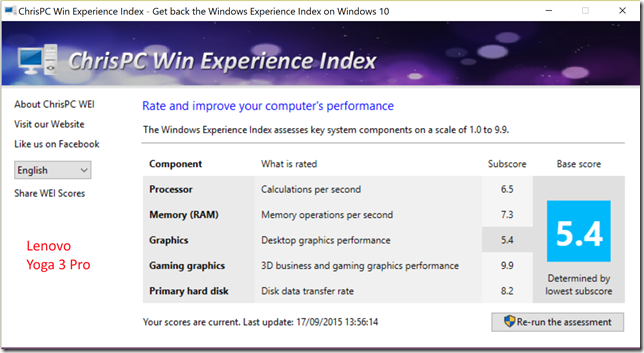
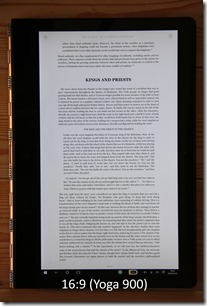

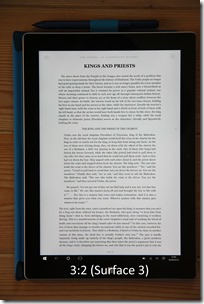




Hallo. Vanuit Singapore schrijf ik u aan. Ik heb zelf wat onderzoek gedaan en vond een nadeel van de Yoga 900 dat er geen dual array microfoon in de laptop zit. Nu lees ik boven: “At the top of the screen is the Yoga 900s’s webcam; capable of 720p @ 30 fps (the same as for the Yoga 900), along with the dual-array microphone.” Is dit zeker?
Well, both models have two microphones in an array – is that a dual array, or two mikes in a single array? You tell me…
According to Lenovo: “Microphone Integrated single digital-array microphone”, but I hope they are wrong or that I misinterpreted it… Who can help us?
It’s a single array, but it has two microphones. You can see the two holes in the top edge of the display glass on both Yogas…
Lenovo’s PSREF documentation also talks of a “dual array microphone” (http://psref.lenovo.com/Product/Lenovo_Yoga_900_13_inch )
Thanks for the review.
You say the CPU in the 900s is an improvement over the pro 3, yet the CPU mark score for the pro 3 is more than 33% higher than that of the 900s. Is that correct?
Paul, yes, it’s interesting, isn’t it? Those were the figures that I obtained from the Pro 3 when I did the review of the Yoga 900 last year. I no longer have the Pro 3, so I can’t rerun the Passmark suite to check. It may be caused by the way Lenovo have set up the system. Intel has made the Core M and chipset such that it can be set to run under different profiles, in order to select for different parameters such as speed, battery life, heat production. The Pro 3 was NOT fanless, so Lenovo could afford to have it run faster and produce more heat. It may well be that in the Yoga 900s, which IS fanless, Lenovo has elected to have it run slightly slower in order to keep the heat down. That slowness is then compensated for by the much better disc performance in the Yoga 900s.
The comment about “the improvement” was in the context of the fact that the Pro 3 uses the previous generation of Core M.
Hi Geoff,
Great review, thanks for that. Is it possible to charge the Yoga 900S via USB-C?
Best,
Johannes
Hi Johannes, no, as far as I’m aware, it is not possible to charge the 900s via the USB-C port. Only via the Lenovo proprietary USB 2.0 port. The charger delivers more power via that port to charge the battery quicker as well.
Thanks for your quick reply!
Wow, really good review. Just felt the need to say thank you for sharing it with us 🙂
Thank you. I just wish that Lenovo would get the damn thing out into the market… It’s a nice machine.
No joke. I check the site just about daily, and it still says Coming Soon. It looks like it is technically available on the Singapore Lenovo site.
How does the 900s stack up to the ms-surface pro 4 running i5 in it? do you think I will be able to day-trade efficiently on it running interactive brokers software with 2 browsers? Thank you
Not having a Surface Pro 4 with an i5 in it, I really couldn’t say. However, on paper, a Core M processor is going to be slower than a Core i5. Would it be fast enough for you and your scenario? Without being able to try it out, it’s impossible to judge…
where do you put the active pen is their a slot for it so you dont lose it?
There’s no slot (the Yoga 900s is too slimline for that), but the pen is supplied with a clip that plugs into a USB slot, so that acts as the pen holder. The clip can also hold the pen in two orientations: parallel with the keyboard, or vertically upright.
Can you say something about temperature with a normal use?
It’s normal – that’s to say I’ve never once thought “this laptop is becoming uncomfortably warm”. In fact, before you asked the question, I’d never thought even about it, which tells me that the thermal design of the Yoga 900s is good.
Pingback: The Yoga 910 – A Review | Geoff Coupe's Blog
I have a YOGA 900 with i7 cpu. What pen will work on it for drawing sketches.
You can’t use any active pens, because the Y900 doesn’t have the necessary digitiser hardware in the screen. Only passive (capacitive) pens will work, because they act like a finger. I don’t use such pens, so I have no recommendations. Sorry.